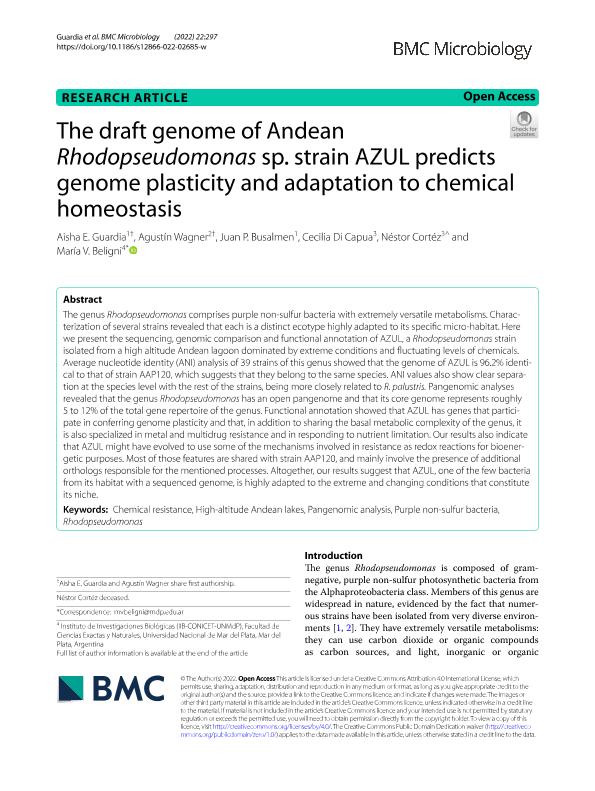Mostrar el registro sencillo del ítem
dc.contributor.author
Guardia, Aisha Elena

dc.contributor.author
Wagner, Agustín
dc.contributor.author
Busalmen, Juan Pablo

dc.contributor.author
Di Capua, Cecilia Beatriz

dc.contributor.author
Cortez, Nestor Ricardo

dc.contributor.author
Beligni, María Verónica

dc.date.available
2023-09-20T12:55:44Z
dc.date.issued
2022-11
dc.identifier.citation
Guardia, Aisha Elena; Wagner, Agustín; Busalmen, Juan Pablo; Di Capua, Cecilia Beatriz; Cortez, Nestor Ricardo; et al.; The draft genome of Andean Rhodopseudomonas sp. strain AZUL predicts genome plasticity and adaptation to chemical homeostasis; BioMed Central; BMC Microbiology; 22; 1; 11-2022; 1-19
dc.identifier.issn
1471-2180
dc.identifier.uri
http://hdl.handle.net/11336/212251
dc.description.abstract
The genus Rhodopseudomonas comprises purple non-sulfur bacteria with extremely versatile metabolisms. Characterization of several strains revealed that each is a distinct ecotype highly adapted to its specific micro-habitat. Here we present the sequencing, genomic comparison and functional annotation of AZUL, a Rhodopseudomonas strain isolated from a high altitude Andean lagoon dominated by extreme conditions and fluctuating levels of chemicals. Average nucleotide identity (ANI) analysis of 39 strains of this genus showed that the genome of AZUL is 96.2% identical to that of strain AAP120, which suggests that they belong to the same species. ANI values also show clear separation at the species level with the rest of the strains, being more closely related to R. palustris. Pangenomic analyses revealed that the genus Rhodopseudomonas has an open pangenome and that its core genome represents roughly 5 to 12% of the total gene repertoire of the genus. Functional annotation showed that AZUL has genes that participate in conferring genome plasticity and that, in addition to sharing the basal metabolic complexity of the genus, it is also specialized in metal and multidrug resistance and in responding to nutrient limitation. Our results also indicate that AZUL might have evolved to use some of the mechanisms involved in resistance as redox reactions for bioenergetic purposes. Most of those features are shared with strain AAP120, and mainly involve the presence of additional orthologs responsible for the mentioned processes. Altogether, our results suggest that AZUL, one of the few bacteria from its habitat with a sequenced genome, is highly adapted to the extreme and changing conditions that constitute its niche.
dc.format
application/pdf
dc.language.iso
eng
dc.publisher
BioMed Central

dc.rights
info:eu-repo/semantics/openAccess
dc.rights.uri
https://creativecommons.org/licenses/by-nc-sa/2.5/ar/
dc.subject
CHEMICAL RESISTANCE
dc.subject
HIGH-ALTITUDE ANDEAN LAKES
dc.subject
PANGENOMIC ANALYSIS
dc.subject
PURPLE NON-SULFUR BACTERIA
dc.subject
RHODOPSEUDOMONAS
dc.subject.classification
Biología Celular, Microbiología

dc.subject.classification
Ciencias Biológicas

dc.subject.classification
CIENCIAS NATURALES Y EXACTAS

dc.title
The draft genome of Andean Rhodopseudomonas sp. strain AZUL predicts genome plasticity and adaptation to chemical homeostasis
dc.type
info:eu-repo/semantics/article
dc.type
info:ar-repo/semantics/artículo
dc.type
info:eu-repo/semantics/publishedVersion
dc.date.updated
2023-06-23T16:33:12Z
dc.journal.volume
22
dc.journal.number
1
dc.journal.pagination
1-19
dc.journal.pais
Reino Unido

dc.journal.ciudad
Londres
dc.description.fil
Fil: Guardia, Aisha Elena. Consejo Nacional de Investigaciones Científicas y Técnicas. Centro Científico Tecnológico Conicet - Mar del Plata. Instituto de Investigaciones en Ciencia y Tecnología de Materiales. Universidad Nacional de Mar del Plata. Facultad de Ingeniería. Instituto de Investigaciones en Ciencia y Tecnología de Materiales; Argentina
dc.description.fil
Fil: Wagner, Agustín. Universidad Nacional de Rosario. Facultad de Ciencias Agrarias; Argentina
dc.description.fil
Fil: Busalmen, Juan Pablo. Consejo Nacional de Investigaciones Científicas y Técnicas. Centro Científico Tecnológico Conicet - Mar del Plata. Instituto de Investigaciones en Ciencia y Tecnología de Materiales. Universidad Nacional de Mar del Plata. Facultad de Ingeniería. Instituto de Investigaciones en Ciencia y Tecnología de Materiales; Argentina
dc.description.fil
Fil: Di Capua, Cecilia Beatriz. Consejo Nacional de Investigaciones Científicas y Técnicas. Centro Científico Tecnológico Conicet - Rosario. Instituto de Biología Molecular y Celular de Rosario. Universidad Nacional de Rosario. Facultad de Ciencias Bioquímicas y Farmacéuticas. Instituto de Biología Molecular y Celular de Rosario; Argentina
dc.description.fil
Fil: Cortez, Nestor Ricardo. Consejo Nacional de Investigaciones Científicas y Técnicas. Centro Científico Tecnológico Conicet - Rosario. Instituto de Biología Molecular y Celular de Rosario. Universidad Nacional de Rosario. Facultad de Ciencias Bioquímicas y Farmacéuticas. Instituto de Biología Molecular y Celular de Rosario; Argentina
dc.description.fil
Fil: Beligni, María Verónica. Consejo Nacional de Investigaciones Científicas y Técnicas. Centro Científico Tecnológico Conicet - Mar del Plata. Instituto de Investigaciones Biológicas. Universidad Nacional de Mar del Plata. Facultad de Ciencias Exactas y Naturales. Instituto de Investigaciones Biológicas; Argentina
dc.journal.title
BMC Microbiology

dc.relation.alternativeid
info:eu-repo/semantics/altIdentifier/url/https://bmcmicrobiol.biomedcentral.com/
dc.relation.alternativeid
info:eu-repo/semantics/altIdentifier/doi/https://doi.org/10.1186/s12866-022-02685-w
Archivos asociados
